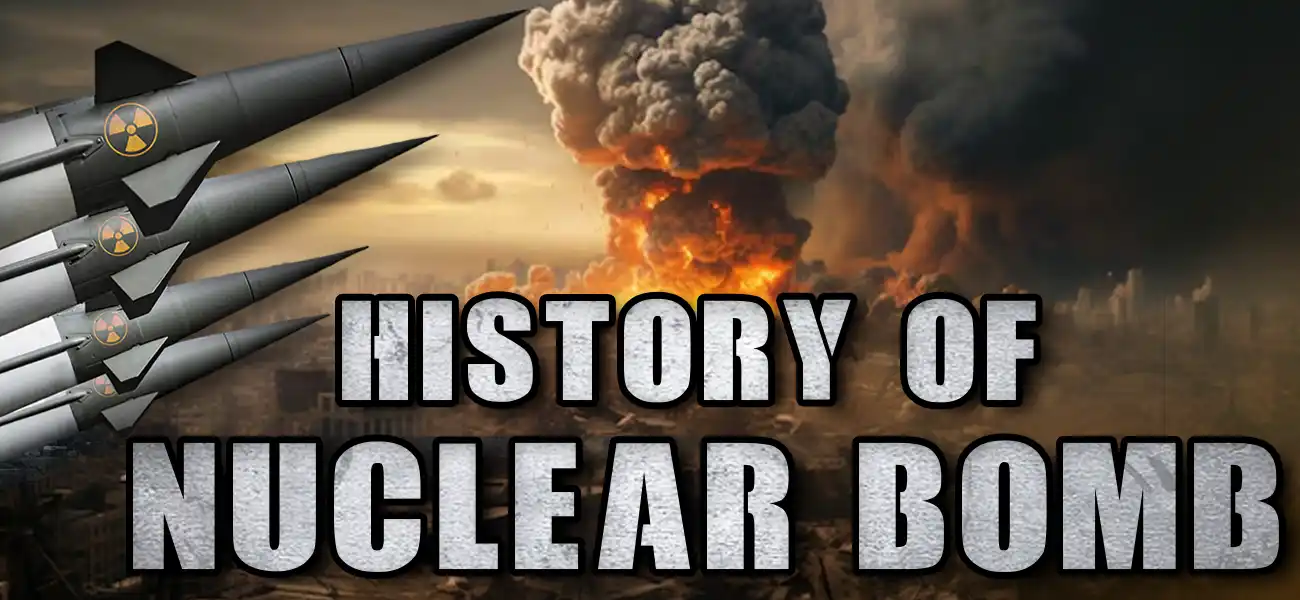History of nuclear bomb

From Discovery to Global Impact - History of Nuclear Bomb
The nuclear bomb, one of the most powerful and destructive inventions in human history, changed the course of warfare, geopolitics, and global security forever. Its origins are rooted in scientific discovery, but its legacy is shaped by war, diplomacy, and deterrence. In this blog, we explore the fascinating and sobering history of the nuclear bomb — from its inception to its lasting global implications.
The Science Behind the Bomb: Theoretical Foundations
The story of the nuclear bomb begins in the early 20th century with breakthroughs in nuclear physics. Scientists such as Albert Einstein, Niels Bohr, and Enrico Fermi laid the foundation for understanding the atom and its enormous energy potential.
In 1905, Einstein’s mass-energy equivalence formula (E=mc²) showed that a small amount of mass could be converted into a huge amount of energy.
By the 1930s, physicists had discovered nuclear fission, the process of splitting an atomic nucleus, which releases vast amounts of energy.
This scientific understanding eventually paved the way for the development of nuclear weapons.
The Manhattan Project: Birth of the Bomb
As World War II intensified, fears that Nazi Germany might develop nuclear weapons first led the United States to launch the Manhattan Project in 1942. This top-secret research program aimed to build the world’s first atomic bomb.
Key highlights:
Led by physicist J. Robert Oppenheimer and General Leslie Groves.
Involved over 130,000 people and facilities in the U.S., UK, and Canada.
The first successful test — known as Trinity — was conducted on July 16, 1945, in the New Mexico desert.
This test marked the dawn of the nuclear age.
Hiroshima and Nagasaki: The First Use in War
Just weeks after the Trinity test, the world witnessed the devastating potential of nuclear weapons.
On August 6, 1945, the U.S. dropped the “Little Boy” uranium bomb on Hiroshima, killing an estimated 140,000 people.
On August 9, “Fat Man”, a plutonium bomb, was dropped on Nagasaki, causing around 70,000 deaths.
Japan surrendered shortly after, ending World War II. While the bombings ended the war, they also opened a new era of nuclear fear and arms race.
The Cold War and Nuclear Arms Race
Post-World War II, the world became polarized between two superpowers — the United States and the Soviet Union. Both nations rapidly developed and tested nuclear weapons, leading to an intense arms race.
Key developments:
In 1949, the Soviet Union conducted its first successful nuclear test.
In the 1950s and 60s, more powerful weapons, such as the hydrogen bomb (H-bomb), were developed.
Nations like the UK, France, and China also joined the nuclear club.
By the 1980s, the world had accumulated tens of thousands of nuclear warheads, many capable of global destruction within minutes.
Nuclear Treaties and Non-Proliferation Efforts
Fearing global annihilation, world leaders and diplomats began efforts to limit and reduce nuclear weapons:
Nuclear Non-Proliferation Treaty (NPT), 1968
Aimed to prevent the spread of nuclear weapons beyond the five recognized nuclear powers.
Encouraged peaceful use of nuclear energy and disarmament.
Comprehensive Nuclear-Test-Ban Treaty (CTBT), 1996
Banned all nuclear explosions for military or civilian purposes.
Strategic Arms Limitation Talks (SALT), START treaties
Agreements between the U.S. and USSR (later Russia) to cap and reduce nuclear arsenals
India and the Nuclear Bomb
India’s nuclear journey began with peaceful nuclear energy programs but transitioned into military capability due to regional security challenges:
1974: Conducted its first nuclear test, “Smiling Buddha”, at Pokhran.
1998: Carried out five nuclear tests under Operation Shakti, declaring itself a full-fledged nuclear power.
India follows a “No First Use” nuclear policy and maintains a minimum credible deterrent.
Modern Nuclear Landscape
As of 2025, the following countries are known to possess nuclear weapons:
United States
Russia
China
France
United Kingdom
India
Pakistan
Israel (undeclared)
North Korea
Despite reduction efforts, geopolitical tensions in regions like Eastern Europe, the Korean Peninsula, and South Asia keep nuclear threats alive.
Ethical Debate and Global Impact
The invention of nuclear weapons triggered global debates on:
Ethics of mass destruction.
Civilian casualties.
Environmental consequences of nuclear war.
Organizations like the International Campaign to Abolish Nuclear Weapons (ICAN) and global leaders continue to advocate for a nuclear-free world.
Power with Responsibility
The history of the nuclear bomb is a story of scientific brilliance, wartime urgency, and long-lasting geopolitical consequences. While it ended wars and ensured deterrence, it also created a world where mistakes can have irreversible consequences.
As global citizens and future leaders, it is vital to understand the history, danger, and responsibility that comes with nuclear power — to ensure that the world never sees another Hiroshima or Nagasaki.
Also Read Top 5 strongest armies in the world
